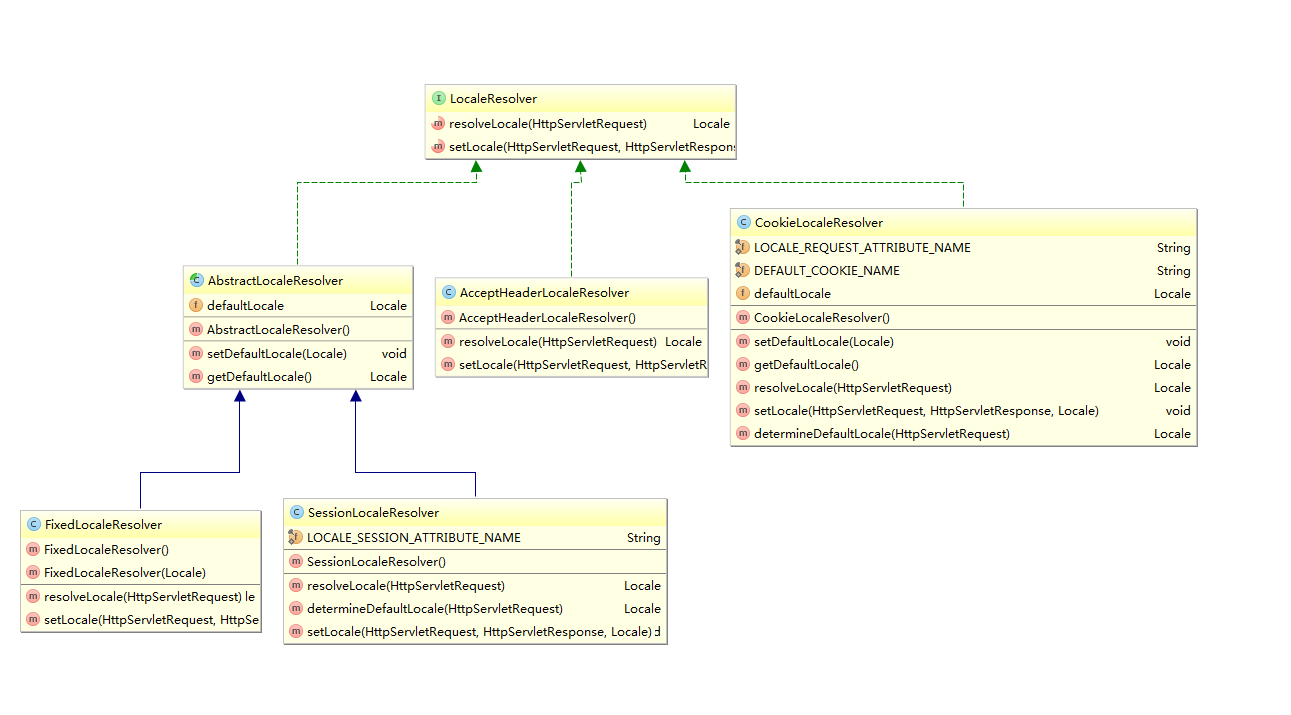一般客户端的语言特性,是通过cookie来传递的,也可以通过request的请求中获得locale的值。
先看CookieGenerator.java
public void addCookie(HttpServletResponse response, String cookieValue) {
Assert.notNull(response, "HttpServletResponse must not be null");
Cookie cookie = createCookie(cookieValue);
Integer maxAge = getCookieMaxAge();
if (maxAge != null) {
cookie.setMaxAge(maxAge);
}
if (isCookieSecure()) {
cookie.setSecure(true);
}
if (isCookieHttpOnly()) {
cookie.setHttpOnly(true);
}
response.addCookie(cookie);
if (logger.isDebugEnabled()) {
logger.debug("Added cookie with name [" + getCookieName() + "] and value [" + cookieValue + "]");
}
}这个地方就是response中回写cookie来存储locale的值。cookieName代表的是cookie的key值。如果我们采用的CookieLocaleResolver.java是本地的locale解析器。默认设置的cookieName是
public static final String DEFAULT_COOKIE_NAME = CookieLocaleResolver.class.getName() + ".LOCALE";继承自LocaleResolver的两个方法实现如下:
public Locale resolveLocale(HttpServletRequest request) {
// Check request for pre-parsed or preset locale.
Locale locale = (Locale) request.getAttribute(LOCALE_REQUEST_ATTRIBUTE_NAME);
if (locale != null) {
return locale;
}
// Retrieve and parse cookie value.
Cookie cookie = WebUtils.getCookie(request, getCookieName()); --批量在cookie中匹配对应key值的cookie
if (cookie != null) {
locale = StringUtils.parseLocaleString(cookie.getValue());
if (logger.isDebugEnabled()) {
logger.debug("Parsed cookie value [" + cookie.getValue() + "] into locale '" + locale + "'");
}
if (locale != null) {
request.setAttribute(LOCALE_REQUEST_ATTRIBUTE_NAME, locale);--设置到request请求中,在spring的拦截器会使用时,拦截request时使用。
return locale;
}
}
return determineDefaultLocale(request); --如果前面的cookie没有读取出来的话,读取的是request中包含的locale信息。
}
public void setLocale(HttpServletRequest request, HttpServletResponse response, Locale locale) {
if (locale != null) {
// Set request attribute and add cookie.
request.setAttribute(LOCALE_REQUEST_ATTRIBUTE_NAME, locale); --设置请求中的locale信息
addCookie(response, locale.toString()); --添加cookie到response中,设置到客户端中。
}
else {
// Set request attribute to fallback locale and remove cookie.
request.setAttribute(LOCALE_REQUEST_ATTRIBUTE_NAME, determineDefaultLocale(request));
removeCookie(response);
}
}public boolean preHandle(HttpServletRequest request, HttpServletResponse response, Object handler)
throws ServletException {
String newLocale = request.getParameter(this.paramName); --查看请求参数中是否有locale的参数名,感觉spring这个地方的处理略显粗糙了点
if (newLocale != null) {
LocaleResolver localeResolver = RequestContextUtils.getLocaleResolver(request); --从spring的容器中获取localeResolver的实现
if (localeResolver == null) {
throw new IllegalStateException("No LocaleResolver found: not in a DispatcherServlet request?");
}
localeResolver.setLocale(request, response, StringUtils.parseLocaleString(newLocale));
}
// Proceed in any case.
return true;
}public static LocaleResolver getLocaleResolver(HttpServletRequest request) {
return (LocaleResolver) request.getAttribute(DispatcherServlet.LOCALE_RESOLVER_ATTRIBUTE); --在请求的属性中是否有localeResolver的实现
}调用方法是DispatcherServlet.java中:
public static final String LOCALE_RESOLVER_ATTRIBUTE = DispatcherServlet.class.getName() + ".LOCALE_RESOLVER";初始化的时候指定对应的key值,对应到调用的地方是:
protected void initStrategies(ApplicationContext context) {
initMultipartResolver(context);
initLocaleResolver(context); --初始化localeResolver
initThemeResolver(context);
initHandlerMappings(context);
initHandlerAdapters(context);
initHandlerExceptionResolvers(context);
initRequestToViewNameTranslator(context);
initViewResolvers(context);
initFlashMapManager(context); }初始化本地化解析的方法调用如下:
private void initLocaleResolver(ApplicationContext context) {
try {
this.localeResolver = context.getBean(LOCALE_RESOLVER_BEAN_NAME, LocaleResolver.class);//bean的值是localeResolver,定义bean值的时候需要bean的id为localeResolver.
if (logger.isDebugEnabled()) {
logger.debug("Using LocaleResolver [" + this.localeResolver + "]");
}
}
catch (NoSuchBeanDefinitionException ex) {
// We need to use the default.
this.localeResolver = getDefaultStrategy(context, LocaleResolver.class); //没找到时候采取的默认策略的localeResolver为org.springframework.web.servlet.i18n.AcceptHeaderLocaleResolver
if (logger.isDebugEnabled()) {
logger.debug("Unable to locate LocaleResolver with name '" + LOCALE_RESOLVER_BEAN_NAME +
"': using default [" + this.localeResolver + "]");
}
}
}spring的mvc拦截器会拦截客户端的请求来抓取到合适的locale解析器来获得locale的属性,从而通过resourceBundle来获得对应的属性文件里面的值。需要注意的点是bean的id需要设置成localeResolver。
分析一下i18n包下的几个类:

AcceptHeaderLocaleResolver --是获取请求头中的locale对象
CookieLocaleResolver --获取的是cookie中传递的locale对象,如果cookie 不存在,获取的也是请求头中的locale对象。其中默认的cookieName是:
public static final String DEFAULT_COOKIE_NAME = CookieLocaleResolver.class.getName() + ".LOCALE";
public static final String LOCALE_SESSION_ATTRIBUTE_NAME = SessionLocaleResolver.class.getName() + ".LOCALE";
上面只是spring的保持和传递locale对象的方式,也可以通过线程的方式来将locale绑定到ThreadLocale上面。来保持在一次请求过程中locale的值。取值的方式也可以参照前面的几种。
后续会加上ResourceBundle中调用的逻辑处理。







 本文深入分析了Spring框架中如何通过Cookie、请求参数和session来传递和存储客户端的locale信息,详细解释了CookieLocaleResolver、SessionLocaleResolver等类的作用,并探讨了如何在请求拦截器中获取并应用locale,以及如何通过ThreadLocale来保持locale值的一致性。
本文深入分析了Spring框架中如何通过Cookie、请求参数和session来传递和存储客户端的locale信息,详细解释了CookieLocaleResolver、SessionLocaleResolver等类的作用,并探讨了如何在请求拦截器中获取并应用locale,以及如何通过ThreadLocale来保持locale值的一致性。

















 1670
1670

 被折叠的 条评论
为什么被折叠?
被折叠的 条评论
为什么被折叠?








